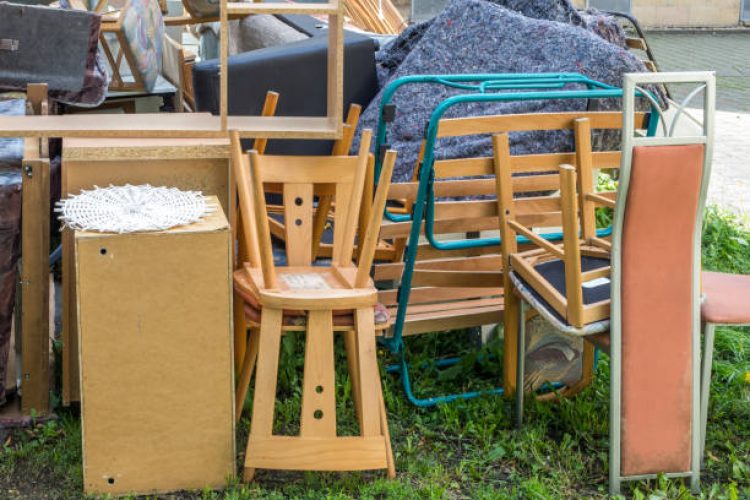Moving to a new home, redecorating, or simply tired of that old couch taking up space? You’re not alone. Every year, millions of people face the same dilemma: what should I do with furniture I no longer want or need? The good news is that throwing it away isn’t your only option—in fact, it shouldn’t be your first choice at all.
According to the EPA, furniture waste generated by Americans in 2017 totaled a staggering 12.2 million tons, and 80.2% of it went to landfill. This massive amount of waste represents not just an environmental problem, but also a missed opportunity. That unwanted dresser, dining table, or armchair could find new life with someone else, be transformed into something entirely different, or even put some extra cash in your pocket.
This comprehensive guide will walk you through all your options for dealing with old furniture responsibly, from donation and resale to creative upcycling and proper recycling. Let’s explore how you can make the most sustainable—and potentially profitable—choice for your unwanted pieces.
Understanding the Furniture Waste Problem
Before diving into solutions, it’s important to understand why this matters. About 10 million tons of furniture were landfilled in 2018, according to the U.S. Environmental Protection Agency (EPA), and the disposal rate is likely higher today as furniture waste has been on the rise for as long as EPA has tracked it.
Part of the problem is “fast furniture”. Produced and sold by some of the biggest names in the furnishing and home improvement industries, these items are made using poor-quality materials and offered at prices so low that many people consider them disposable. Combined, the low quality and value of fast furniture mean it’s usually too expensive or difficult to repair, sell, or donate.
The environmental impact extends beyond just landfill space. Furniture waste contributes to deforestation, greenhouse gas emissions, and the release of toxic chemicals into soil and water. By choosing alternatives to disposal, you’re making a meaningful difference for the planet.
Option 1: Donate Your Furniture to Charity
Donating furniture is often the easiest and most rewarding way to get rid of items you no longer need. Not only does it help people in your community, but it also keeps usable furniture out of landfills and may even qualify you for a tax deduction.
Where to Donate Furniture
Several national and local organizations accept furniture donations, and many offer free pickup services:
Habitat for Humanity ReStore
Most Habitat ReStores offer furniture pickup as well as pickup for other large donation items including appliances, building materials and more. Habitat ReStore accepts new and gently used appliances, furniture, building materials, household goods and more from individuals and companies. The proceeds from ReStore sales support Habitat’s mission to build affordable homes for families in need.[2^]
The Salvation Army
Established in 1865, The Salvation Army provides a wide range of services, including disaster relief, rehabilitation centers, and assistance for the homeless. Furniture donations support The Salvation Army’s Adult Rehabilitation Centers, which provide housing, food, counseling, and employment services for individuals battling addiction.
Goodwill
Goodwill is one of the biggest thrift store chains in the United States. Most Goodwill stores offer free donation pickup services, especially for larger items. Their mission focuses on providing job training and employment opportunities for people who face barriers to employment.
Furniture Banks
The Furniture Bank Network consists of registered charities that help individuals donate gently used furniture to people in need. This collective helps other organizations with furniture pickup. They serve a wide range of people, including but not limited to those who are unemployed, immigrants, families that have experienced domestic violence or homelessness, and those affected by natural disasters/fires.
Tips for Donating Successfully
- Check condition requirements: Most charities only accept furniture in good, usable condition without major damage, stains, or odors
- Schedule pickup in advance: Many organizations require 1-2 weeks notice for furniture pickup
- Get a receipt: Save your donation receipt for potential tax deductions
- Clean items before donation: Wipe down surfaces and vacuum upholstered pieces
- Call ahead: Confirm the organization accepts your specific items before scheduling pickup
Option 2: Sell Your Furniture Online or Locally
If your furniture is still in decent condition, why not make some money from it? The online marketplace has made selling used furniture easier than ever before.
Best Platforms for Selling Furniture
Facebook Marketplace
With Facebook Marketplace, potential buyers in your area will be shown your items when they browse the platform. Listing items is free – and you won’t be paying any fees for sold items, which is a bonus. The platform’s integration with Facebook profiles also adds a layer of trust that other platforms may lack.
Craigslist
Craigslist is a simple online marketplace that doesn’t charge any standard listing or service fees. That makes it easy to create an account and start listing furniture to sell in a few minutes or less. While the interface may look dated, Craigslist remains popular for local furniture sales.
AptDeco
For those in major cities, AptDeco offers a more curated marketplace experience. Sustainability is at the heart of what we do. We believe that pre-loved furniture should be the first consideration before new. Over 12 million tons of used furniture get landfilled each year. We’re on a mission to change that by making furniture circular.[3^] The platform handles pickup and delivery, though they take a commission on sales.
OfferUp and Letgo
These mobile-first platforms make it easy to list items quickly with photos taken directly from your smartphone. They’re particularly popular with younger buyers looking for affordable furniture options.
Chairish
For vintage, antique, or high-end furniture, Chairish provides a more specialized marketplace. The platform takes a higher commission but connects you with buyers specifically looking for quality pieces.
Tips for Selling Furniture Successfully
Take Quality Photos: Properly clean the furniture as best you can, wiping down any leather and wood surfaces and vacuuming or steam-cleaning upholstery. Then, stage them in a well-lit room to showcase their potential. It’s also important to take pictures from multiple angles. Photographing the furniture from the front, sides, and back with detail shots helps potential buyers have a better understanding of the furniture’s scale.
Price Competitively: Research similar items to determine fair pricing. Generally, used furniture sells for 50-70% of its original retail price, depending on condition and brand.
Write Detailed Descriptions: Include dimensions, materials, brand name, age, condition details, and any flaws. Honesty builds trust with potential buyers.
Be Responsive: Reply to inquiries quickly and be flexible with viewing times to increase your chances of a sale.
Consider Local Pickup Only: Furniture is heavy and expensive to ship. Most successful furniture sales happen locally with buyer pickup.
Option 3: Upcycle and Repurpose Your Furniture
One of the most creative and sustainable options is to transform your old furniture into something new and functional. Upcycling extends the life of furniture while creating unique pieces that reflect your personal style.
Popular Upcycling Ideas
Transform Dressers
Instead of throwing out your old dresser, turn it into a piece you can use anywhere in your house! Flipping a dresser into a DIY buffet table is an easy way to add more storage to your home. Using stencils, bright paint colors, or a fresh stain will help your DIY sideboard stand out while providing convenient storage![4^]
Old dressers can also become bathroom vanities, kitchen islands, TV stands, or entryway benches with some creativity and basic DIY skills.
Repurpose Old Doors
Transforming an old door into a headboard is a great way to update your bedroom set. Remove the paint and knobs from the door, sanding down any rough edges and removing splinters. Once the surface is smooth and even, add some crown molding to the sides and style with chalk paint for a rustic feel, or a fresh coat of mineral paint for a waterproof and washable finish. Once the paint dries, affix your stylish new headboard to the wall behind your bed.
Doors can also become unique shelving units, desk tops, or even coffee tables.
Create Storage from Drawers
You can give your chest of drawers a furniture makeover by upcycling the old drawers into bedside tables. With the handle side up, add small wooden legs to the bottom of the drawer and a shelf to the middle of the drawer. Place your new side table in your bedroom or use it as an end table for your living room.
Turn Chairs into Benches
Remove the seats from multiple matching chairs and connect them with a wooden plank to create a unique bench for an entryway or dining area.
Ladder Shelving
Give an old wooden ladder a fresh coat of paint and repurpose it for storage! Mount it in your kitchen as a place to rest your cookbooks. Use it to hang towels in your bathroom. Or lean it against a wall in your living room as a DIY quilt ladder or fun plant storage.
Benefits of Upcycling
Environmental Impact: Upcycling is the act of recycling an object or material and turning it into a higher quality item than its original form. Upcycling is an environmentally beneficial practice that allows you to convert unwanted materials or byproducts into items of value, reducing waste and your carbon footprint. Upcycled furniture projects contribute to a more sustainable lifestyle by extending the life cycle of certain materials, rather than polluting the environment by discarding them in a landfill.
Cost Savings: Upcycling is significantly cheaper than buying new furniture, often requiring only paint, hardware, or basic materials.
Unique Style: No two upcycled pieces are exactly alike, giving your home a one-of-a-kind character.
Skill Building: DIY furniture projects help you develop practical skills in woodworking, painting, and design.
Option 4: Recycle or Properly Dispose of Furniture
When furniture is truly at the end of its useful life—broken beyond repair, heavily damaged, or contaminated—recycling or proper disposal becomes necessary.
Furniture Recycling Options
To recycle household furniture it’s best to search for a recycling center in your area that can handle f-waste. Many communities have specialized recycling facilities that can break down furniture into component materials.
What Can Be Recycled:
- Wood can be chipped for mulch or composite materials
- Metal frames and components can be melted down and reused
- Some plastics can be recycled depending on type
- Glass components can be recycled through standard glass recycling
- Textiles and foam are more challenging but some facilities accept them
Municipal Pickup and Disposal
In most areas, municipal waste management will pick up furniture, or offer a place for furniture waste drop off, but there’s little guarantee that it will be recycled. Check with your local waste management department about:
- Bulk item pickup schedules
- Special furniture collection days
- Drop-off locations for large items
- Any associated fees
Junk Removal Services
Professional junk removal companies like 1-800-GOT-JUNK, LoadUp, or local services will pick up furniture for a fee. Load Up picks up your furniture and donates it for you, partnering with Goodwill, Salvation Army, and Habitat for Humanity. They have moved millions of items already and planted over 26,000 trees.
Option 5: Give It Away for Free
Sometimes the fastest way to get rid of furniture is simply to offer it for free to someone who needs it.
Free Furniture Platforms
Freecycle
Freecycle.org has free furniture items available for pickup at different sites near you. This grassroots network connects people giving away items with those who need them, all completely free.
Buy Nothing Groups
Local Buy Nothing Facebook groups operate on a gift economy where members give and receive items within their community without any exchange of money.
Nextdoor
Your neighborhood social network is perfect for offering furniture to nearby residents who can pick it up quickly.
Curbside Alerts
In some communities, simply placing furniture on the curb with a “free” sign results in quick pickup by neighbors or passersby. However, check local regulations first as this isn’t permitted everywhere.
Environmental Benefits of Responsible Furniture Disposal
Making thoughtful choices about old furniture has significant environmental impacts:
Reduces Landfill Waste: When furniture is sent to a landfill, it often releases harmful chemicals and pollutants into the environment. These chemicals can leach into the ground and contaminate soil and water supplies. In addition, landfills are a major source of methane gas, which is a greenhouse gas that contributes to climate change. By recycling furniture instead of sending it to a landfill, we can help to reduce pollution and protect our environment.
Conserves Natural Resources: Recycling furniture helps to conserve resources. Trees are often cut down to provide wood for new furniture, but recycling old furniture can help to reduce this demand. In addition, recycling furniture often requires less energy than manufacturing new pieces, which further conserves resources.
Prevents Deforestation: Deforestation is a huge negative impact of the production of new wood furniture, as it contributes to biodiversity loss, soil erosion, and 15% of global greenhouse gas emissions. With recycled furniture, these items are not contributing further to deforestation.
Making Your Decision: Which Option Is Right for You?
The best choice for your old furniture depends on several factors:
Choose DONATION if:
- Your furniture is in good, usable condition
- You want to help your community
- You need a tax deduction
- You don’t want the hassle of selling
- Free pickup is available in your area
Choose SELLING if:
- Your furniture is in good to excellent condition
- You need extra money
- You’re willing to photograph and list items
- You can handle communications with buyers
- You have time to wait for the right buyer
Choose UPCYCLING if:
- You have basic DIY skills
- You enjoy creative projects
- You want unique, personalized furniture
- The piece has good bones but needs cosmetic work
- You have time for a project
Choose RECYCLING if:
- The furniture is damaged beyond repair
- It has safety issues (like broken frames)
- It’s contaminated or has pest damage
- No one else would want it
- You’ve exhausted donation options
Choose GIVING AWAY if:
- You need furniture gone immediately
- It’s not worth money but still usable
- You want to help your local community
- You don’t need a tax receipt
Preparing Furniture for Its Next Chapter
Regardless of which option you choose, properly preparing your furniture will ensure the best outcome:
- Clean thoroughly: Vacuum, dust, and wipe down all surfaces
- Make minor repairs: Tighten screws, fix wobbly legs, touch up scratches
- Take accurate measurements: Know dimensions for listings or to confirm fit for donations
- Document condition: Take photos from multiple angles showing any damage
- Disassemble if needed: Large pieces often need to be broken down for transport
- Remove personal items: Check all drawers and compartments
Conclusion: Your Furniture’s Second Act
Furniture often gets dumped illegally, and eight times out of 10 simply ends up in a landfill.[1^] But it doesn’t have to be this way. Whether you choose to donate, sell, upcycle, recycle, or give away your old furniture, you’re making a choice that benefits both the environment and your community.
The key is to plan ahead. Don’t wait until moving day to figure out what to do with that old couch or dining set. Research your options early, schedule pickups in advance, and give yourself enough time to explore the best choice for each piece.
Remember, a UK survey found that one-third of people threw away still-functional furniture rather than selling or donating it. Don’t let perfectly good furniture go to waste. With the resources and options outlined in this guide, you have everything you need to ensure your old furniture finds a worthy second act.
Every piece of furniture that’s donated, sold, upcycled, or properly recycled instead of landfilled represents a small victory for sustainability. Multiply that by millions of households making better choices, and the impact becomes substantial. Your old furniture doesn’t have to be the end of a story—it can be the beginning of a new one.
References
[1^] Recycle Track Systems. (2024). Furniture waste – The forgotten waste stream. https://www.rts.com/blog/furniture-waste-a-growing-issue/
[2^] Habitat for Humanity. Donate goods to Habitat for Humanity ReStore. https://www.habitat.org/restores/donate-goods
[3^] AptDeco. Buy and Sell Used Furniture—We Pickup & Deliver. https://www.aptdeco.com/
[4^] Extra Space Storage. (2023). 16 DIY Upcycled Furniture Ideas. https://www.extraspace.com/blog/home-organization/diy-ideas-to-upcycle-repurpose-furniture/
[5^] U.S. Environmental Protection Agency. (2024). Durable Goods: Product-Specific Data. https://www.epa.gov/facts-and-figures-about-materials-waste-and-recycling/durable-goods-product-specific-data













